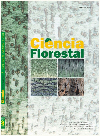
|
Ciência Florestal
Centro de Pesquisas Florestais - CEPEF, Departamento de Ciências Florestais - DCFL, Programa de Pós Graduação em Engenharia Florestal - PPGEF
ISSN: 0103-9954
EISSN: 0103-9954
Vol. 29, No. 1, 2019, pp. 208-220
|
 Bioline Code: cf19017
Bioline Code: cf19017
Full paper language: Portuguese
Document type: Research Article
Document available free of charge
|
|
|
Ciência Florestal, Vol. 29, No. 1, 2019, pp. 208-220
| en |
Natural regeneration in an area of shallow cut Pinus taeda  L. L.
Secco, Rubia Tatiana; Acra, Luiz Antônio & Coraiola, Márcio
Abstract
The present study aimed the floristic analysis of natural regeneration in Pinus taeda L. shallow cut area approximately
two years after suppression of a planting of about fifteen years. The study area is located in the city of Campo Largo –
PR state, which original forest typology belongs to the Araucaria Rainforest, a total of 5.5 hectares. For the sampling
of the natural regeneration of the area, ten plots of 10 m x 10 m each were installed, and, within each of them, five
subplots totaling 5 m², of which were collected all individuals with arboreal characteristics, sample adequacy was
achieved. It was sampled 406 individuals belonging to 64 botanical species. The family Asteraceae showed the
highest number of copies, followed by Solanaceae and Primulaceae. The ecological diversity index of Shannon, and
the equability index of Pielou presented values of 3.42 and 0.82 respectively. The number of individuals in pinus
regeneration in the study area was 23 copies, with a high value when compared to other species. However, it can be
concluded that the number of native individuals, as well as the species richness of the natural regeneration, showed
no impairment due to previous settlement with exotic species.
Keywords
Natural regeneration; Rain Forest; Pinus taeda; Reforestation
|
| |
| pt |
Regeneração natural em área de corte raso de Pinus taeda  L. L.
Secco, Rubia Tatiana; Acra, Luiz Antônio & Coraiola, Márcio
Resumo
O presente estudo teve como objetivo a análise florística da regeneração natural em área de corte raso de Pinus taeda
L. aproximadamente dois anos após supressão integral de um povoamento de cerca de quinze anos. A área de estudo
localiza-se na cidade de Campo Largo – PR, cuja tipologia florestal original pertence à Floresta Ombrófila Mista, em
um total de 5,5 hectares. Para a amostragem da regeneração natural da área foram instaladas dez parcelas de 10 m por
10 m cada, e no interior de cada uma delas outras cinco subparcelas, totalizando 5 m², de onde foram coletados todos
os indivíduos de características arbóreas. A suficiência amostral foi alcançada. Foram amostrados 406 indivíduos,
pertencentes a 64 espécies botânicas. A família Asteraceae foi a que apresentou maior número de exemplares,
seguida de Solanaceae e Primulaceae. O índice de diversidade ecológica de Shannon, e índice de equabilidade de
Pielou apresentaram valores de 3,42 e 0,82, respectivamente. O número de indivíduos de pinus em regeneração na
área estudada foi de 23 exemplares, apresentando um alto valor quando comparado às demais espécies. No entanto,
pode-se concluir que o número de indivíduos nativos, bem como a riqueza de espécies da regeneração natural, não
apresentou comprometimento devido ao anterior povoamento com a espécie exótica.
Palavras-chave
Regeneração natural; Floresta Ombrófila Mista; Pinus taeda; Reflorestamento
|
| |
© Copyright 2019 - Ciência Florestal
Alternative site location: http://cascavel.ufsm.br/revistas/ojs-2.2.2/index.php/cienciaflorestal/index
|
|
